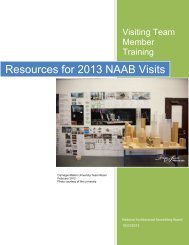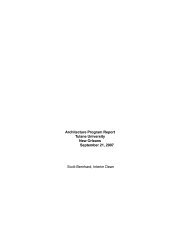NAAB Architecture Program Report (APR) 2013 - Tulane School of ...
NAAB Architecture Program Report (APR) 2013 - Tulane School of ...
NAAB Architecture Program Report (APR) 2013 - Tulane School of ...
You also want an ePaper? Increase the reach of your titles
YUMPU automatically turns print PDFs into web optimized ePapers that Google loves.
<strong>Tulane</strong> University<strong>Architecture</strong> <strong>Program</strong> <strong>Report</strong>September <strong>2013</strong>space near the Pantheon. This facility is leased from the Pantheon Institute, an entity run by an Italian-American (Romolo Martemucci) who was previously a tenured full pr<strong>of</strong>essor at Penn State University.The facility includes a desk for each student, classrooms, review space, wireless network, printers,scanners, and an <strong>of</strong>fice for the faculty. We have used this space for three years now, and it works verywell for our purposes. Students live in the neighborhood <strong>of</strong> Trastevere with easy access to publictransportation. This semester long program which occurs during the fall semester <strong>of</strong> the fourth year forundergraduate students, fall semester <strong>of</strong> the third year for graduate, MArch I students, includes anumber <strong>of</strong> field trips throughout Italy to destinations such as Venice, Florence, Siena, Berlin, andVienna. Student take a Fall Break excursion to a location outside Italy, and are afforded additional timeduring the course <strong>of</strong> the program for individual travel.The required curriculum <strong>of</strong> the Rome <strong>Program</strong> comprises an advanced level design studio (DSGN4100, <strong>Architecture</strong> Option Studio), an architectural drawing course (AVSM 3310), a history <strong>of</strong> the citycourse (AHST 6350), a course in international practices (APFC 4242), and a course in contemporaryRoman culture (AHST 4510).Japan <strong>Program</strong> – Summer <strong>2013</strong>Through classroom and study-tour curriculum, students compare Kyoto and New Orleansfrom historical, architectural, and cultural perspectives in order to gain a deep appreciation forJapanese contributions to art and architecture. By comparing traditional and modern buildings andsites, students gain cross-cultural insights that lay the foundation for future collaborations and artisticapplications. This course is made possible by the generous sponsorship <strong>of</strong> the Japan FoundationJapan-America Collegiate Exchange Travel <strong>Program</strong>, subsidizing 2/3 <strong>of</strong> the travel expense.II.2.3. Curriculum Review and DevelopmentThe Associate Dean <strong>of</strong> Academics has primary oversight <strong>of</strong> the curriculum, working in closecollaboration with the <strong>School</strong>’s Curriculum Committee, the other Associate Deans and the Dean.The TSA Curriculum Committee meets on a monthly basis and considers all key curriculum issues onbehalf <strong>of</strong> the faculty. There are student members on the Curriculum Committee as well. When issuesare recommended by this Committee, they move up to the full faculty for consideration, first readings,and second readings with votes.The Studio-Walk-Through – For a long time, the <strong>Tulane</strong> <strong>School</strong> <strong>of</strong> <strong>Architecture</strong> has conducted daylongevents to give the faculty a comprehensive overview <strong>of</strong> the studio curriculum each semester. Typicallythese begin with presentations by studio coordinators for each <strong>of</strong> the core years and pr<strong>of</strong>essorsteaching required courses in any given semester. The faculty also looks at Option Studios and Thesis.Students are invited to this open presentation and discussion. The faculty then walks through the entirebuilding, with student work clearly organized on each desk. Following this, the faculty meets for severalhours to discuss findings. This has been an invaluable tool for gaining crosscutting understanding <strong>of</strong>strengths, weaknesses and opportunities for the program. We have made a number <strong>of</strong> improvementsbased on this process, and the faculty involvement has been extensive.Curriculum Committee Membership<strong>2013</strong>-2014Bruce Goodwin, RAJudith Kinnard, FAIAByron Mouton, AIAWendy Redfield, AIA (Associate Dean <strong>of</strong> Academics)Carol Reese, Ph.D. (Architectural Historian)Scott Ruff68














